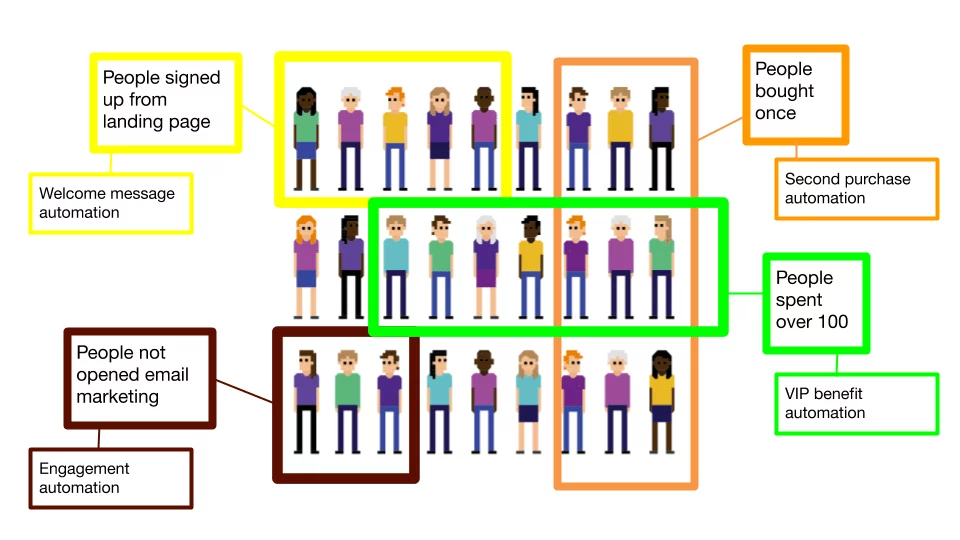Let’s make your email marketing strategy work for you.
Way way back in May 2018, inboxes all over the EU groaned beneath the weight of the endless ‘do you still want to hear from us?’ emails. Not the finest hour for email marketing.
The effects of GDPR inspired countless memes, lampooning the efforts of subscriber-hungry businesses. It also made many question if email marketing was still worth the investment.
Marketing gurus tell businesses to use video, get on Instagram, or jump on the latest trend. They even tout Facebook Messenger bots as email’s replacement.
It’s easy to see why people keep ringing the death knell of email marketing.
Email marketing is very much alive and kicking
In a word, NO. It’s estimated that over 335 billion emails were sent every day by the end of 2023. This figure is projected to increase to 392.5 billion daily e-mails by 2026. Not only that, when it comes to online advertising e-mail has seen higher click-through-rates than on social media. In Belgium and Germany, these were 5.5 and 4.3 percent respectively – compared to the 1.3 percent global average CTR for social media during the same time period. Proof that email remains a hugely important marketing channel.
That said, you may find customers less willing to hand over their email address. Especially if they know your freebie will lead to a deluge of ‘buy my stuff’ emails.
So the key question is how will your email marketing stand out?
What can I do to make the most of my email marketing?
How about considering a change in your email marketing strategy, and work on changing your customer’s perception of email marketing. Namely, make your email marketing about something relevant to them. Something your audience want to see in their inbox.
Let’s look at 6 ways to do that.
1. Stop Calling it Marketing
We know, this sounds contentious. But you’re not ‘marketing’ your services to customers. They’re already customers so you don’t need to ‘market’ to them.
Instead, you need to build a relationship with them. And you do that by talking to them.
The best way to talk to customers?
Email. Consider it a conversation, not selling.
Here at Websand, we subscribe to Seth Godin’s permission marketing philosophy. (There’s that word again).
Focus on sending the message that the customer needs at that moment in time. And you’ll never send another ‘marketing email’ again.
2. Know Exactly Who You’re Talking To
Customers aren’t stupid. They can recognise an email marketing strategy that isn’t sophisticated. A blast to a list, desperate for sales at the end of the quarter.
They also know when you’re not talking to them. Because you’re trying to talk to everyone.
People understand that they might be one in a huge crowd. But you’ll often hear them say they felt a great singer or orator was directly addressing them at a big event.
Your emails need to do the same thing. The best way to do that is to identify your target customer, or your best customer, and write to them. Address their pain points and offer solutions. They’ll feel you wrote that email for them because it contains the information they need.
That email became a communication between two people. You exchanged an idea. And that customer didn’t see the exchange as email marketing. They saw it as conversation.
3. Get Personal
We don’t just mean ‘use a mail merge tag’ to add a customer’s name to an email. You can still do that. But you can pepper your messages with information that shows you know your customers.
Look at Amazon. Once you buy a product, they send an email recommending other related products you might like. Their recommendations are accurate. And they need to be – their reputation rests on it.
Those emails help build trust between Amazon and their customer. Amazon is helpful, sending content the customer might make use of. (Which is super useful when you’re struggling to buy presents for difficult relatives).
But they also direct customers back onto Amazon to buy more products.
Work out how you can send content based on that customer’s interactions with you. Consider setting up triggers to email a user when they haven’t logged into your app or website in a set period. Remind them how useful your solution is. Or send them top tips based on how they interact with their account.
Whatever you do, make it relevant to your relationship and make it useful.
4. Make Your Emails Worth Opening
When was the last time you opened an email that made you smile? Or taught you something valuable?
Contrast that with the last time you opened an email and scowled. You couldn’t hit ‘delete’ fast enough on that one.
If you’ve felt that way, then your customers have too. Don’t let your emails get lost in the sea of nonsense flooding inboxes.
Even something as simple as the first ‘welcome’ email can be full of your tone of voice. It lets your subscriber know what to expect from you. Rewrite order and dispatch emails so they sound like a human wrote them.
Treat your online customers as you would visitors to a physical store. Give them that customer experience that keeps them coming back… just do it in a digital format.
5. Segmentation
Segmentation is a great way to improve your personalisation. Gone are the days of slapdash blasts sent to your whole list. We’ve found that emails sent to segments can double your open rate when compared to an ordinary campaign. Why waste that opportunity?

You can segment your customers based on whatever makes sense for you. Then send them the content they need. If you run a blog, segment customers based on which blog posts they signed up from. That shows they’re interested in that content, so why not send them more?
Or segment customers based on what they buy from you. Or how often they buy it.
Segmentation ensures that only the customers that need those messages ever see them. Which means the customers that don’t need them get cleaner inboxes.
6. Automation
These steps all lead to the grand finale – automation. The art of automated emails lies in pre-empting what your customers need and when they’ll need it.
Write those emails and set up triggers to send them. That way, they’ll only receive those emails when they need them. Perhaps your product needs a replacement every three months. Send a reminder email after two and a half months. Maybe customers collect loyalty points, but they expire after three months. Remind them in enough time for them to use them. Provide travel services? Send them helpful packing or sightseeing checklists as their booking approaches.
Whatever it is, define the ‘trigger’ that causes the email to send. Your customers can only ever receive them at the right time for them. Your email marketing is about what your customer needs to receive instead of what you need to send.
And that’s how you change perception
When you focus on changing how your customers perceive email marketing, you make your email marketing strategy work for you. The outcome is always an improvement the ROI from your email marketing investment. While you won’t always change how your audience feel about it in email as a channel in general, you can change their attitude toward your content.
That leads to them opening more emails and taking more actions. But it also leads to better communication between brands and customers. If you are sell a product or service that needs consideration, then need they need to ‘know, like and trust’ you before they’ll buy. Make your email marketing strategy work for you and you’ll hit all three.
Are you looking to switch up your approach to email marketing, or simply want to start driving growth. Get in touch.
We’ll help you change your customer’s perceptions and make your email marketing strategy work for you.
We’re standing by!
It’s time to start getting more from your email marketing
Sign up for a free Websand demo and let’s show you how to get the best from your email marketing.
